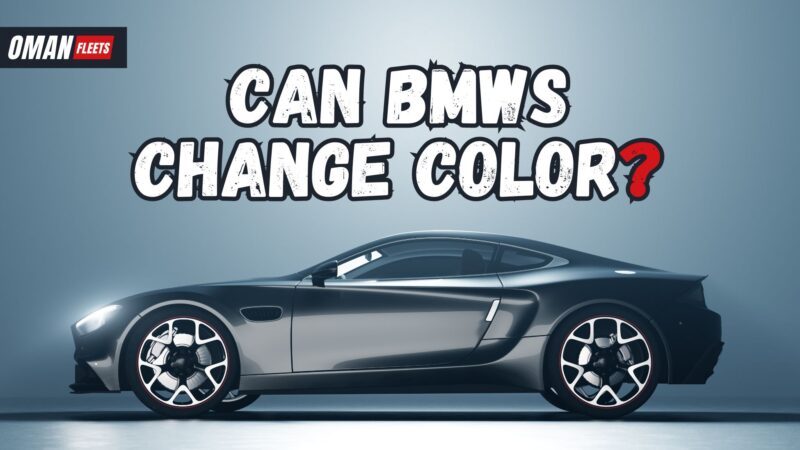Imagine driving down the street in your sleek BMW, then suddenly deciding you want to change the color from black to purple. With just a tap on your phone, your car transforms to match your whim! While it may sound like science fiction, this vision of Color Changing BMWs could become reality sooner than you think thanks to some revolutionary technology being developed by BMW.
Color changing cars provide endless opportunities for customization and could fundamentally transform the look and feel of our vehicles. BMW is at the forefront of this innovative concept that blends material science, software, and design in visionary new ways.
In this post, we’ll explore how BMW’s color changing technology works, look at where they are in development, consider potential timelines for consumer availability, and ponder what the future may hold when dynamic exteriors become mainstream. Ready to glimpse the shape-shifting cars of tomorrow? Let’s dive in!
How Does BMW’s Color Changing Technology Work?
So how does a car change color on command? It’s all thanks to a sci-fi sounding technology called “electronic ink” or E Ink for short.
Special E Ink films are laser precisely cut and attached to a car’s body panels. These films contain millions of microscopic capsules filled with positively and negatively charged pigment particles suspended in fluid.
When an electric signal is applied, the pigments are either attracted to the top or bottom of the capsule, causing it to appear white or black. By carefully controlling the voltage, engineers can trigger specific spots on the wrap to lighten or darken.
Add in the ability to incorporate other hues, and suddenly you have a full color e-paper display covering the exterior of your ride! It’s technology that until recently was only seen on Kindle e-readers, now scaled up and repurposed for personalized automotive style.
Tracing the Evolution of BMW’s Color Changing Concepts
BMW didn’t go straight to full color exteriors with their first attempts at experimenting with E Ink technology on cars. It’s been an iterative process of learning and refinement across a series of forward-thinking concept vehicles:
- iX Flow (2022) – The world’s first color changing car debuted at CES 2022. Using E Ink, it shifted between black and white exterior tones.
- i Vision Dee (2023) – An updated concept showed off multi-color potential with 32 dynamic paint options.
- i5 Flow Nostokana (2024) – Combined color shifting panels with intricate artistic patterns and designs.
With each incarnation, BMW has expanded the capabilities of the technology and moved closer to their vision of production readiness. But their latest concept car, the i5 Flow Nostokana, represents the biggest leap forward yet on the path to color changing consumer vehicles.
BMW’s Newest Concept Features Mobile Artistry
The BMW i5 Flow Nostokana is a visually stunning design showcase that pushes the E Ink technology further than ever before. The unique art car’s color shifting exterior mimics the traditional motifs of renowned South African artist Esther Mahlangu’s Ndebele art in vibrant, reconfigurable displays.
A Moving Tribute to BMW’s Art Car Legacy
The i5 project pays homage to BMW’s long history of art car masterpieces while looking to the future. Esther Mahlangu famously designed the 1991 BMW 525i art car, making her both the first woman and the first African artist to participate in the legendary program.
BMW engineers brought her vision into the modern era by translating the shapes and colors of her original piece onto a state-of-the-art automotive canvas. The result is a showcase of BMW’s design heritage and their dedication to cross-cultural creative collaboration.
Pushing E Ink Technology to New Extremes
From a technical perspective, the i5 represents the leading edge of color e-paper engineering. Its body contains over 1,300 individually controllable E Ink segments.
By carefully calibrating the electrical signals to each panel, BMW can mimic the flowing shapes and vibrant colors of Mahlangu’s work in continuously adaptable combinations. The vehicle almost feels alive as patterns ripple across its flanks.
The name “Nostokana” also has significance, incorporating Esther Mahlangu’s indigenous South African name as an homage to her influence. Every aspect of the model embodies the concept of blending technology and artistry in groundbreaking new ways.
When Will We See Color Changing BMWs On The Road?
The million dollar question around BMW’s shifting paint concepts is when will they transition from jaw-dropping auto show spectacles to options that everyday consumers can spec for their new rides?
While we can’t expect chameleon cars next year, BMW’s visionary engineers are working to overcome the remaining hurdles that stand between them and road-ready production vehicles.For a closer look at BMW’s color-changing concept car, check out the video from CNN here.
Conquering Durability and Repairability
Two of the biggest challenges are increasing durability and developing affordable repair procedures. The E Ink films will need to withstand years of exposure to weather, car washes, debris, and daily driving. Any damage also has to be fixable without exorbitant costs.
To reach production standards, BMW is continuing to refine the technology while gathering data from concept vehicles and working to improve robustness. But they’ve already come a long way and are optimistic about having color changing cars that can hold up in the real world.
Targeting Consumer Availability in the Late 2020s
Based on their rapid progress so far, BMW engineers estimate that color changing car tech could reach showrooms in the late 2020s. They envision a future where the E Ink films are applied like spray paint coatings during assembly, allowing full customization.
Of course, meeting that timeline depends on clearing regulatory hurdles and other factors. But given BMW’s proven tradition of pioneering automotive technologies, it’s an exciting goal that feels firmly within reach.
Why Dynamic Exteriors Are Game Changers
Aside from the sheer novelty of morphing your ride’s look on a whim, color changing car tech like BMW’s E Ink solutions provide some brilliant functional benefits too.
Unlimited Personalization and Expression
First and foremost, the ability to alter your exterior opens up a new world of customization. Your car becomes a dynamic canvas you can modify to match your outfit, show team spirit, celebrate holidays, or just refresh your style whenever the urge strikes.
Your vehicle reflects your personality, instead of being defined the day it rolls off the assembly line. Considering cars are the 2nd largest purchase most people make, that flexibility adds tremendous value.
Helpful Visual Cues
Beyond just aesthetics, color shifts can provide helpful visual cues as well. Imagine flashing a unique pattern to more easily locate your car in a hectic parking lot.
Or having your vehicle automatically turn bright red when the battery needs charging or flip blue if the tire pressure drops. The possibilities for functional communication are endless.
Enhanced Efficiency
Changing between light and dark colors based on weather conditions can also boost efficiency. A white exterior reflects sunlight rather than absorbing heat on hot days, reducing air conditioning needs.
The opposite applies in cold weather, with black shells absorbing warmth from the sun and reducing heating requirements. Smart color adaptation helps cut energy costs.
When Will Color Changing Cars Go Mainstream?
BMW is starting by targeting their color morphing concepts at high-end market segments first. But they hope to eventually make the technology affordable and ubiquitous. What will it take to reach that goal?
Lowering Manufacturing Costs
Like any new automotive feature, the path to widespread adoption depends on driving down costs through manufacturing improvements. As BMW streamlines E Ink film production and installation, prices should gradually become more attainable.
Ensuring Rugged Reliability
Durability and resilience are also prerequisites for color changing cars to succeed long-term. BMW is already making strides on this front, but continued refinements to withstand the elements will be needed.
Navigating Regulations
New technologies require new rules. BMW will need to cooperate closely with regulatory bodies as they shape laws around dynamic exteriors. Building those relationships now smooths the transition.
With diligence and innovation, BMW believes color changing cars could reach full mainstream integration by the late 2020s. What an amazing makeover that would be for our streets and parking lots!
The Open Road Ahead for Customization Tech
Color changing car surfaces represent just the first step into a future filled with shape-shifting transportation and unlimited dynamism.
BMW’s Ethos of Forward-Thinking Design
As demonstrated by their persistence in developing E Ink exteriors, BMW embraces the role of pioneering new automotive technologies, even when skepticism arises.
They lean into imaginative ideas that change perspectives on what’s possible. It’s that kind of bold innovation that transforms entire industries.
Glimpsing the Future of Personalized Mobility
Color shifting body wraps unlock a new world of customization and expression. One day, we may take for granted smart glass with adjustable tint, tactile surfaces that morph textures, and fully transformable vehicle interiors and exteriors.
BMW’s color changing concepts offer just a taste of the malleable, personalized future of mobility. Their visionary research is lighting the way ahead. The most exciting discoveries still await just around the next corner!
So while color changing BMWs on dealership lots may still be a few years away, know that the brilliant minds at the legendary automaker are hard at work making that dream a reality. With their relentless passion for pioneering innovation, the roads of tomorrow promise to be far more dynamic and customizable than ever before imagined.



